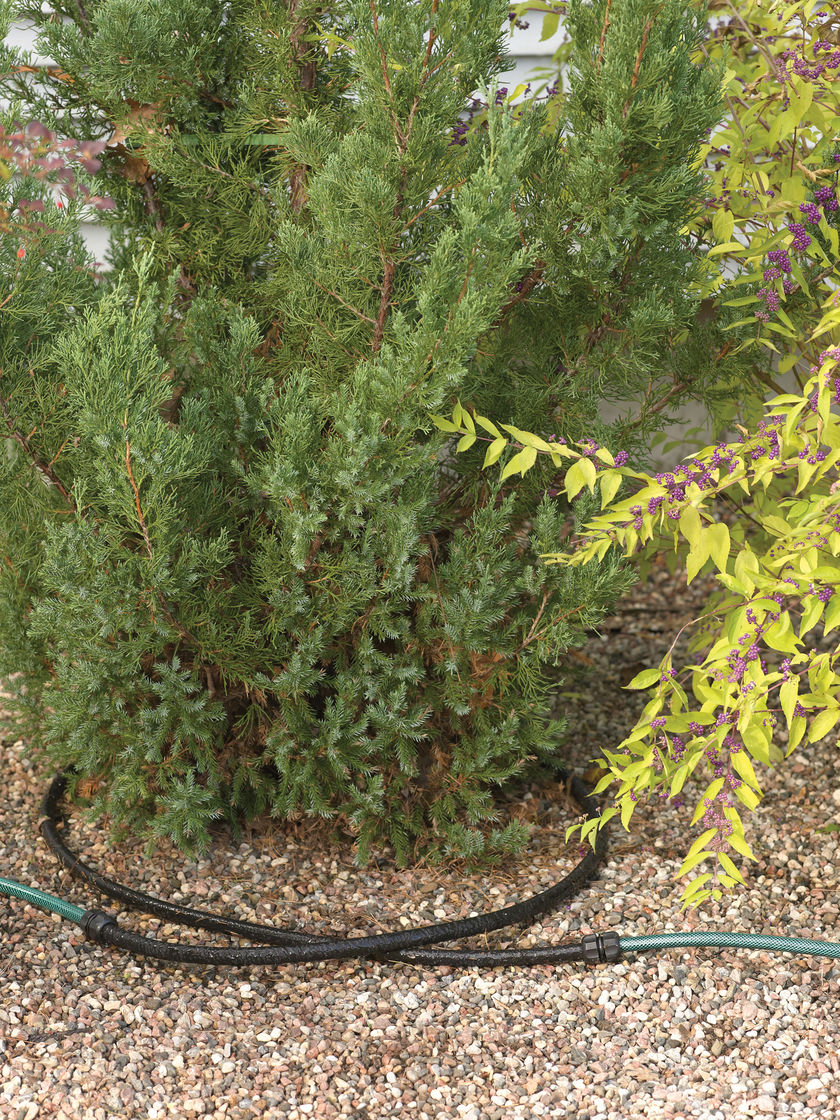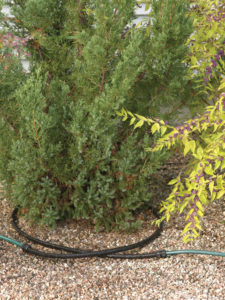
Autumn Gardening Includes Mindful Watering
Soaker hoses such as this kit from Gardener’s Supply Company are a convenient way to irrigate fall shrubs
By Thomas Christopher
As the leaves drift down from the trees, there’s a temptation to regard the gardening year as over. And while it’s true that nature has, for the most part, put growth above ground on hold, it’s also a fact that our plants are still active underground. Early to mid-fall is one of the most important periods for root growth, and how woody plants and perennial plants are cared for now plays an important role in determining how they will perform next year. That’s why it’s so important to make sure that your plants get the water they need through this critical period. So don’t put away your hose just yet.
The need for irrigation in fall is enhanced by the weather typical of the season: the sunny, dry days that are so common may be ideal for football, but they tend to deplete the soil of moisture. Indeed, if we go for 10-14 days without a good, soaking rain storm, you should water the garden.
Newly planted perennials, shrubs and trees are the first concern, as their limited root systems are less effective at drawing moisture from the soil. Use a soaker hose to apply water right around their bases, and moisten the soil to a depth of 12 inches. As a general rule, newly planted trees will need approximately 10 gallons of water per inch of trunk diameter (Measure this 6 inches above the ground). Newly planted shrubs, as long as they are small (less than 3 feet tall) will be fine with an application of 5 gallons. Larger shrubs will need more – if you splurged on a specimen 6 feet tall or more, give it 20 gallons.
Another class of plants that particularly benefit from fall watering are evergreens. Because they keep their needles or leaves year-round, these plants are especially vulnerable to dehydration when the ground is frozen and water is unavailable to their roots, so it’s particularly important that they enter the winter well-hydrated. Broad leaf evergreens such as rhododendrons and hollies are especially at risk in this respect, so make sure they get the irrigation they need in fall. You’ll find that an investment of water at this time of year will be reflected in a noticeable reduction in brown, winter-killed needles and leaves next spring.
Herbaceous perennials and ground covers on exposed, windy sites or fast-draining sandy soils are also at risk from fall and winter drought. Again, if they don’t receive any natural irrigation from rainstorms for a period of 10-14 days, wet their roots with a hose-end sprinkler. Apply the water slowly so that it soaks in and moistens the soil deeply rather than just running away over the surface of the ground.
Fall root growth is, of course, especially important for the bulbs you have just planted. Be sure to water these well, too.
Mulch is another effective tool for maintaining soil moisture in dry fall weather.
I’m not a great fan of shredded bark mulches, if nothing else because of the cost. I prefer to recycle the fall leaves by chopping them up with an inexpensive electric leaf shredder and applying around trees and shrubs and over dormant perennials to a depth of a couple of inches. This not only helps to keep the soil moist, it also insulates it against frost, prolonging the season of root growth. By insulating the soil, mulch also moderates the effect of the rapid temperature swings we often experience in winter, which can heave newly planted perennials right out of the ground.
The need for irrigation diminishes but doesn’t entirely end with the onset of winter. Take advantage of winter warm spells when the soil thaws temporarily to make sure that evergreens get a drink. This is especially important with evergreens on sunny south or west-facing slopes, and those tucked in against south or west-facing walls.
Thomas Christopher is the co-author of “Garden Revolution” (Timber Press, 2016) and is a volunteer at Berkshire Botanical Garden. berkshirebotanical.org
Be-a-Better-Gardener is a community service of Berkshire Botanical Garden, one of the nation’s oldest botanical gardens in Stockbridge, MA. Its mission to provide knowledge of gardening and the environment through 25 display gardens and a diverse range of classes informs and inspires thousands of students and visitors on horticultural topics every year. Thomas Christopher is the co-author of Garden Revolution (Timber press, 2016) and is a volunteer at Berkshire Botanical Garden. berkshirebotanical.org.



